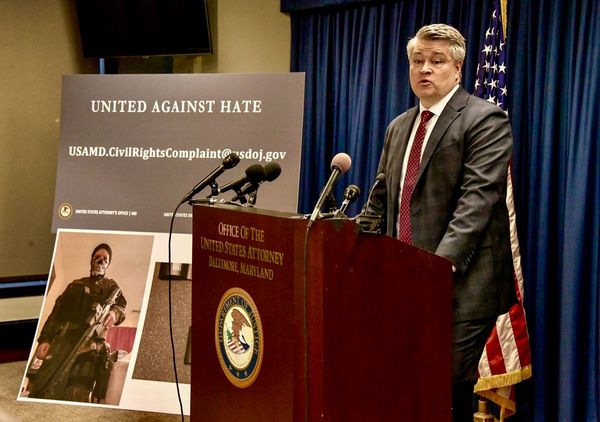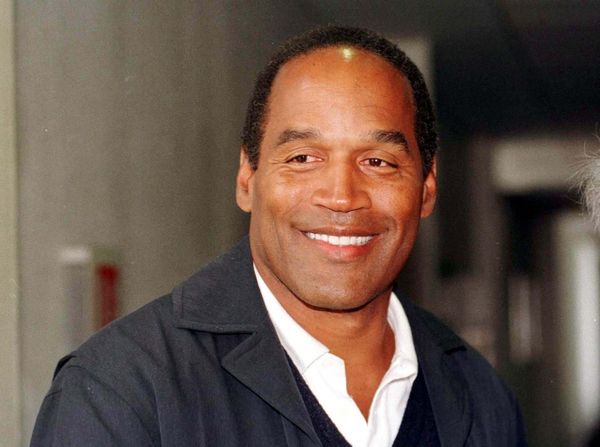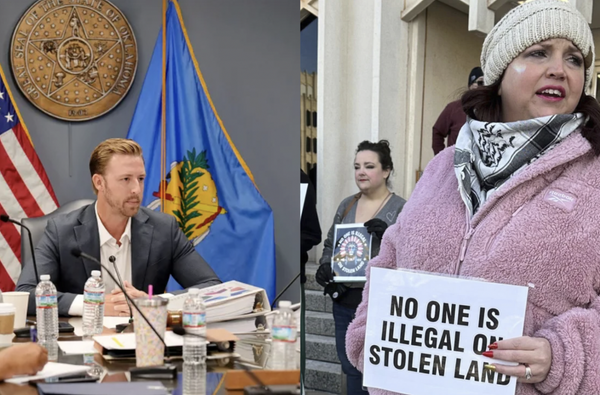As the saying goes, confidence is key in business. And Elizabeth Holmes was confident.
It was an apparently unshakable belief in her product that helped her to raise hundreds of millions of dollars from investors, including some of the world's most powerful people.
With their backing, her company, Theranos, promised to revolutionise medical diagnostics with technology that could conduct clinical blood tests with just the prick of a finger.
Hidden from the public was the fact the technology never worked as intended.
But her sales pitch did.
Buzz surrounding her company's potential propelled her into the Forbes Rich List as the youngest female billionaire and wealthiest self-made woman on the planet — on paper at least.
Despite a patchy record, Theranos's blood work services were offered to doctors and patients, many of whom put their trust its technology and the promises Holmes made.
However, by the end of 2021, she faced an altogether different sales job.
Taking the stand over the course of two weeks, Holmes tried to convince 12 men and women she shouldn't be sent to prison for defrauding investors and patients.
The start-up
If you've ever been to the doctor to have a blood test, you'll know it can be an uncomfortable experience.
A significant amount of blood is drawn and the results can take hours or days. That's not even mentioning the physical discomfort that patients can experience.
It was this that Elizabeth Holmes — who often made a point in interviews to mention her phobia of needles and blood — said she wanted to change by starting the company at age 19.
She envisioned a testing revolution that would remove the need for a needle.
"We've made it possible to eliminate the tubes and tubes of blood that traditionally have to be drawn from an arm."
With that promise, she found support from bigtime investors, including Rupert Murdoch and the family of former US education secretary Betsy DeVos.
After operating in "stealth mode" for years, the company exploded onto the Silicon Valley scene in the early 2010s, bringing Holmes's profile to the fore.
She soon had the pose perfected. Imitating an "OK" sign, she'd perch one of Theranos's tiny test containers between her thumb and forefinger, mere drops of blood inside, to show off the technology at photo shoots.
"This woman invented a way to run 30 lab tests on only one drop of blood," one headline declared.
"This CEO is out for blood," said another.
The company appeared to be moving from strength to strength, with Holmes the skivvy-clad visionary at its helm.
She welcomed a visit to the company from then-vice president Joe Biden and shared stages with Bill Clinton and Chinese billionaire Jack Ma as the press compared her to her idol, Steve Jobs.
But cracks began to appear in late 2015, when a now-famous article from the Wall Street Journal took a different angle.
"Hot startup Theranos has struggled with its blood-test technology," its headline read.
Bleeding credibility
The finger prick blood tests were meant to be analysed with a proprietary machine called a Theranos Sample Processing Unit (TSPU).
It was advertised as being able to perform a full range of tests but, in reality, it struggled badly.
"Faking it until you make it has always been part of Silicon Valley's DNA," Wall Street Journal reporter John Carreyrou told the ABC in 2018, shortly before criminal charges were filed.
"Unfortunately [faking it], in this case, was defrauding investors, making claims to investors that were absolutely not true."
Eventually, The Wall Street Journal's reporting was echoed by criminal and civil action against Ms Holmes and Theranos's president, Ramesh "Sunny" Balwani.
The criminal indictment alleged the TSPU had problems with accuracy and reliability, could not perform the number of tests advertised, was slower than some competing technology, was unable to compete with conventional machines, and could not manage simultaneous testing from multiple patients.
When some of these issues were first made public, Theranos initially went on the defensive, and Ms Holmes personally appealed to investor Rupert Murdoch, who owns The Wall Street Journal, to kill the story.
She also went on US TV to defend her life's work.
Just a year later, Forbes Magazine — which had estimated Ms Holmes' net worth at $US4.5 billion ($6.2 billion) due to her controlling stake in the business — changed its assessment of her net worth to "essentially nothing".
However, claims about the failures of Theranos went beyond the inadequacies of its blood-testing technology.
It was also alleged the company knew about the problems and lied repeatedly to cover them up.
In 2018, the US Securities and Exchange Commission brought civil fraud charges against Ms Holmes and Theranos, alleging she was responsible for misleading investors over the TSPU's performance.
"They deceived investors by, among other things, making false and misleading statements to the media, hosting misleading technology demonstrations, and overstating the extent of Theranos's relationships with commercial partners and government entities, to whom they had also made misrepresentations," it said in its complaint.
Among the allegations levelled by the regulator were that Holmes and Theranos raised $US700 million ($975 million) from investors by:
- tricking investors with demonstrations of the TSPU by secretly using traditional third party machines
- using the same, modified third-party analysers instead of its own machines for some retail testing, despite advertising that was not the case
- overstating the breadth of a contract Theranos had signed with the US military
- misleading investors about the progress of its retail contracts
- claiming it would make $100 million in revenue in 2014 and $1 billion in 2015, despite actually making negligible amounts in those years.
Ms Holmes agreed to settle the civil action in exchange for giving up her majority stake and voting rights in Theranos, being barred from heading a company for 10 years, and paying a $US500,000 fine.
While the settlement did not amount to an acceptance of wrongdoing, just months later she found herself facing more serious criminal charges of wire fraud, linked to her conduct as head of Theranos.
The testing problem
It wasn't just millionaire investors and large corporate partners who were stung by problems with Theranos's technology.
When the company secured a deal with pharmacy chain Walgreens to offer "wellness centres" in store, regular people came into the firing line.
The centres were advertised as a place where patients could have blood "either taken from a tiny finger stick or a micro-sample taken from traditional methods, eliminating the need for larger needles and numerous vials of blood".
However, when the technology was offered to patients, the problems only became more apparent.
Testimony from the trial included a woman who received a false positive result, suggesting she had HIV antibodies, and another with a history of miscarriages who was told her pregnancy had failed, despite it later resulting in a healthy baby.
US media reporting of the trial also included evidence that Holmes resisted and ignored advice from her own experts that the tests would sometimes show up PSAs while testing women's blood — a clear error as PSA stands for prostate-specific antigen and can only come from males.
Was Elizabeth Holmes in control?
But the breadth of Theranos's technological failings became a side issue in the trial when Holmes took the stand.
Suddenly, her personal life was thrust into the spotlight in the US District Court of Northern California.
The key issue in the trial was whether she intended to mislead investors and patients, or whether she was a failed businesswoman, naive to how bad the situation was.
Was she deliberately lying to trick people into giving her money, or was she acting in good faith, even as her business began to crumble? Was she even acting under her own free will at the time of the charged offences?
The man behind the last question is Ramesh "Sunny" Balwani, Holmes's former boyfriend, ex-business partner and co-accused.
While the two faced identical charges, they are being tried separately.
During at-times tearful evidence, Holmes made allegations of how their intense relationship included emotional and sexual abuse.
She said she fell under the spell of a man 19 years older than her, who had offered solace at a difficult time in her life — she turned to him for support after she was raped as a student.
She was made to read out saccharine texts between the two while on the stand, becoming visibly upset at the request by prosecutors to verbalise texts calling him her "tiger".
But much of her testimony — which spanned more than 25 hours, spread over two weeks — was spent blaming Mr Balwani, who had also served as president and chief operating officer of Theranos.
She told the court that Mr Balwani had neglected to fix problems with the blood-testing technology, and that he was controlling in the extreme.
Mr Balwani did not give evidence in the trial but has denied all claims of abuse, for which he has not been charged. He has also pleaded not guilty to fraud charges and will be tried in early 2022.
However, Holmes did give some concessions about things she would do differently at the helm of Theranos if she had her time over.
She admitted to adding the logos of Pfizer and other drug makers to reports, which gave the impression Theranos technology had been validated by other industry figures.
Holmes also acknowledged that she did not pay heed to warnings from lab staff that the technology did not work as intended.
But she also framed her time as chief executive as being driven by a belief in the potential of her product.
She said some of her furtive behaviour could be explained by a desire to protect Theranos's trade secrets, and her lawyers painted her as the captain of a sinking ship, not a criminal trying to get away with fraud.
"Did she leave? No, she stayed. Why? Because she believed in this technology," her lawyer, Kevin Downey, told jurors.
But her position as "captain" was used against her by prosecutor Robert Leach, who had her concede that she was the person with the most power and influence over Theranos.
"I felt that," Ms Holmes said.
Called out
The mammoth trial of Elizabeth Holmes began in September and wrapped up just before Christmas, with the jury sent into deliberations in December.
It had heard from 30 witnesses, with Holmes being given the last word before closing arguments, where she was alternately painted as "building a business, not a criminal enterprise" and "choosing fraud over business failure".
Jury members were required to parse masses of evidence in their deliberations before they eventually delivered their verdict, finding her guilty of four charges, not guilty on another four. They were unable to reach a verdict on a further three counts.
The materials they viewed ranged from scientific testimony to internal emails, personal notes, memos and texts.
Tendered at the trial was a daily schedule belonging to Ms Holmes, scrawled on paper from a Singapore hotel.
Below its details of her 4am wakeup, her diet for the day and her meals was a series of affirmations by which to abide throughout the day.
"I show no excitement … ALL ABOUT BUSINESS," she wrote, shortly above another rule:
"I call bullshit immediately."
It was advice reporters, prosecutors and regulators also took when it came to Theranos's claims of a finger-prick blood test, sparking a litany of investigations that ultimately led to her downfall.
She now faces up to 20 years in prison for each of the four guilty verdicts.
ABC/AP







